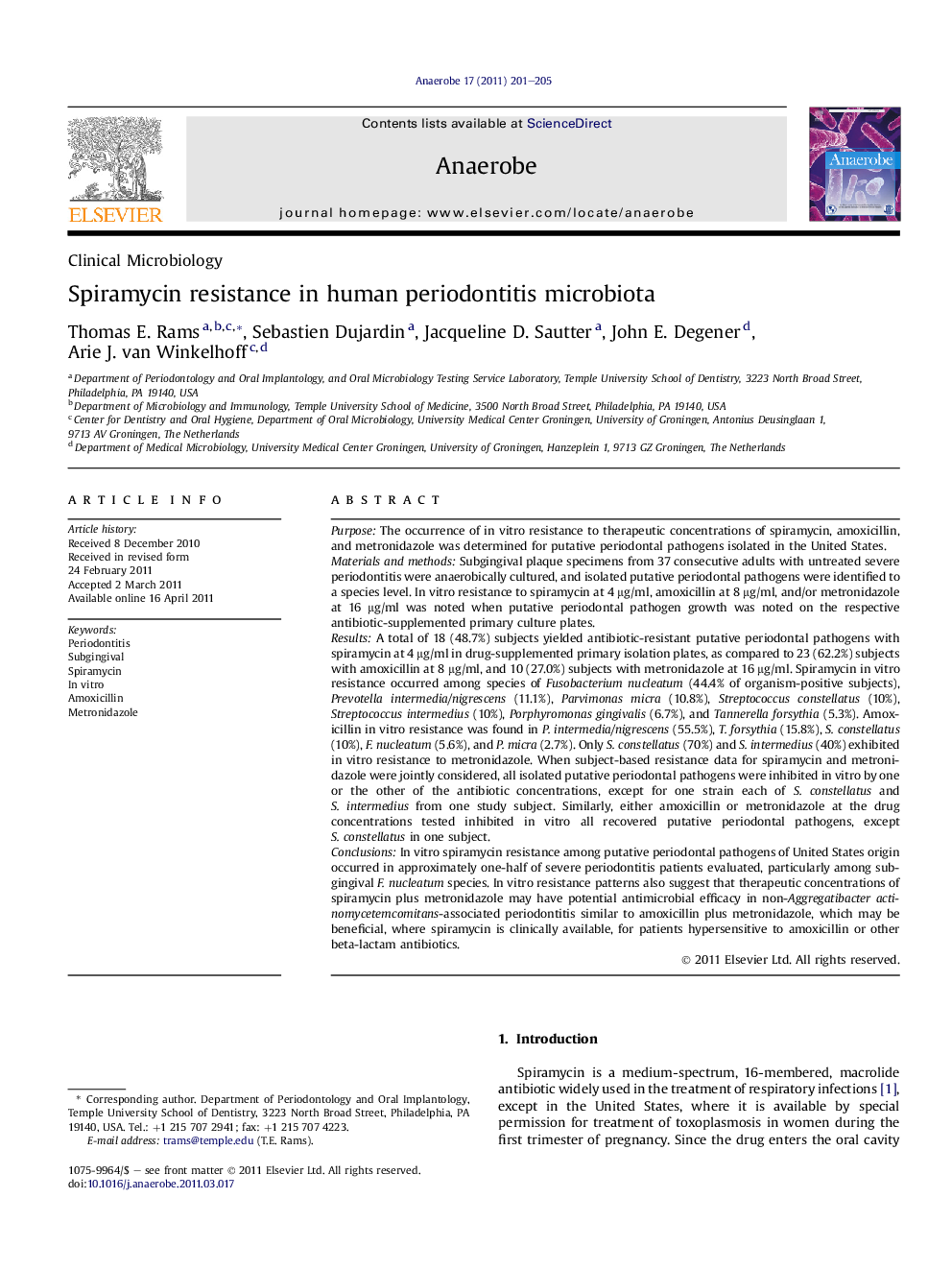| کد مقاله | کد نشریه | سال انتشار | مقاله انگلیسی | نسخه تمام متن |
|---|---|---|---|---|
| 3395489 | 1221688 | 2011 | 5 صفحه PDF | دانلود رایگان |

PurposeThe occurrence of in vitro resistance to therapeutic concentrations of spiramycin, amoxicillin, and metronidazole was determined for putative periodontal pathogens isolated in the United States.Materials and methodsSubgingival plaque specimens from 37 consecutive adults with untreated severe periodontitis were anaerobically cultured, and isolated putative periodontal pathogens were identified to a species level. In vitro resistance to spiramycin at 4 μg/ml, amoxicillin at 8 μg/ml, and/or metronidazole at 16 μg/ml was noted when putative periodontal pathogen growth was noted on the respective antibiotic-supplemented primary culture plates.ResultsA total of 18 (48.7%) subjects yielded antibiotic-resistant putative periodontal pathogens with spiramycin at 4 μg/ml in drug-supplemented primary isolation plates, as compared to 23 (62.2%) subjects with amoxicillin at 8 μg/ml, and 10 (27.0%) subjects with metronidazole at 16 μg/ml. Spiramycin in vitro resistance occurred among species of Fusobacterium nucleatum (44.4% of organism-positive subjects), Prevotella intermedia/nigrescens (11.1%), Parvimonas micra (10.8%), Streptococcus constellatus (10%), Streptococcus intermedius (10%), Porphyromonas gingivalis (6.7%), and Tannerella forsythia (5.3%). Amoxicillin in vitro resistance was found in P. intermedia/nigrescens (55.5%), T. forsythia (15.8%), S. constellatus (10%), F. nucleatum (5.6%), and P. micra (2.7%). Only S. constellatus (70%) and S. intermedius (40%) exhibited in vitro resistance to metronidazole. When subject-based resistance data for spiramycin and metronidazole were jointly considered, all isolated putative periodontal pathogens were inhibited in vitro by one or the other of the antibiotic concentrations, except for one strain each of S. constellatus and S. intermedius from one study subject. Similarly, either amoxicillin or metronidazole at the drug concentrations tested inhibited in vitro all recovered putative periodontal pathogens, except S. constellatus in one subject.ConclusionsIn vitro spiramycin resistance among putative periodontal pathogens of United States origin occurred in approximately one-half of severe periodontitis patients evaluated, particularly among subgingival F. nucleatum species. In vitro resistance patterns also suggest that therapeutic concentrations of spiramycin plus metronidazole may have potential antimicrobial efficacy in non-Aggregatibacter actinomycetemcomitans-associated periodontitis similar to amoxicillin plus metronidazole, which may be beneficial, where spiramycin is clinically available, for patients hypersensitive to amoxicillin or other beta-lactam antibiotics.
Journal: Anaerobe - Volume 17, Issue 4, August 2011, Pages 201–205